Standards Worldwide
Standards Worldwide
Phone +49 30 58885700-07

Standard [CURRENT]
ASTM G 137:2024
Standard Test Method for Ranking Resistance of Plastic Materials to Sliding Wear Using a Block-On-Ring Configuration
- German title
- Einordnung der Gleitverschleißbeständigkeit von Plastwerkstoffen mit Hilfe einer Block-auf-Ring-Anordnung
- Publication date
- 2024
- Original language
- English
- Pages
- 7
- Publication date
- 2024
- Original language
- English
- Pages
- 7
- DOI
- https://dx.doi.org/10.1520/G0137-24
Product information on this site:
Quick delivery via download or delivery service
Buy securely with a credit card or pay upon receipt of invoice
All transactions are encrypted
Short description
1.1 This test method covers a laboratory procedure to measure the resistance of plastic materials under dry sliding conditions. The test utilizes a block-on-ring geometry to rank materials according to their sliding wear characteristics under various conditions. 1.2 The test specimens are small so that they can be molded or cut from fabricated plastic parts. The test may be run at the load, velocity, and temperature which simulate the service condition. 1.3 Wear test results are reported as specific wear rates calculated from volume loss, sliding distance, and load. Materials with superior wear resistance have lower specific wear rates. 1.4 This test method allows the use of both single- and multi-station apparatus to determine the specific wear rates. 1.5 The values stated in SI units are to be regarded as the standard. The values given in parentheses are for information only. 1.6 This standard does not purport to address all of the safety concerns, if any, associated with its use. It is the responsibility of the user of this standard to establish appropriate safety, health, and environmental practices and determine the applicability of regulatory limitations prior to use. 1.7 This international standard was developed in accordance with internationally recognized principles on standardization established in the Decision on Principles for the Development of International Standards, Guides and Recommendations issued by the World Trade Organization Technical Barriers to Trade (TBT) Committee.
ICS
19.060,
83.140.01
DOI
https://dx.doi.org/10.1520/G0137-24
Also available in
Loading recommended items...
Loading recommended items...
Loading recommended items...
Loading recommended items...
